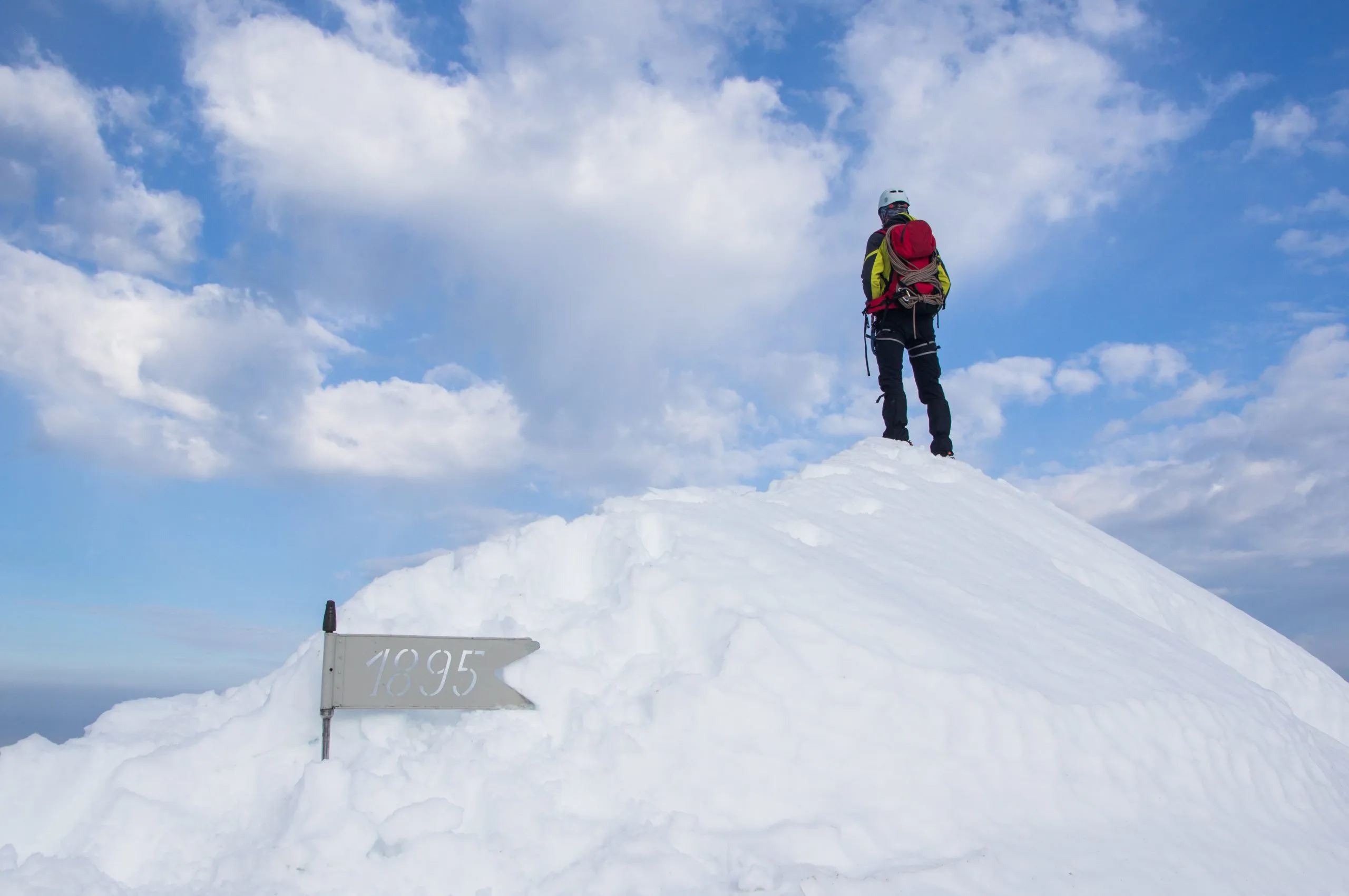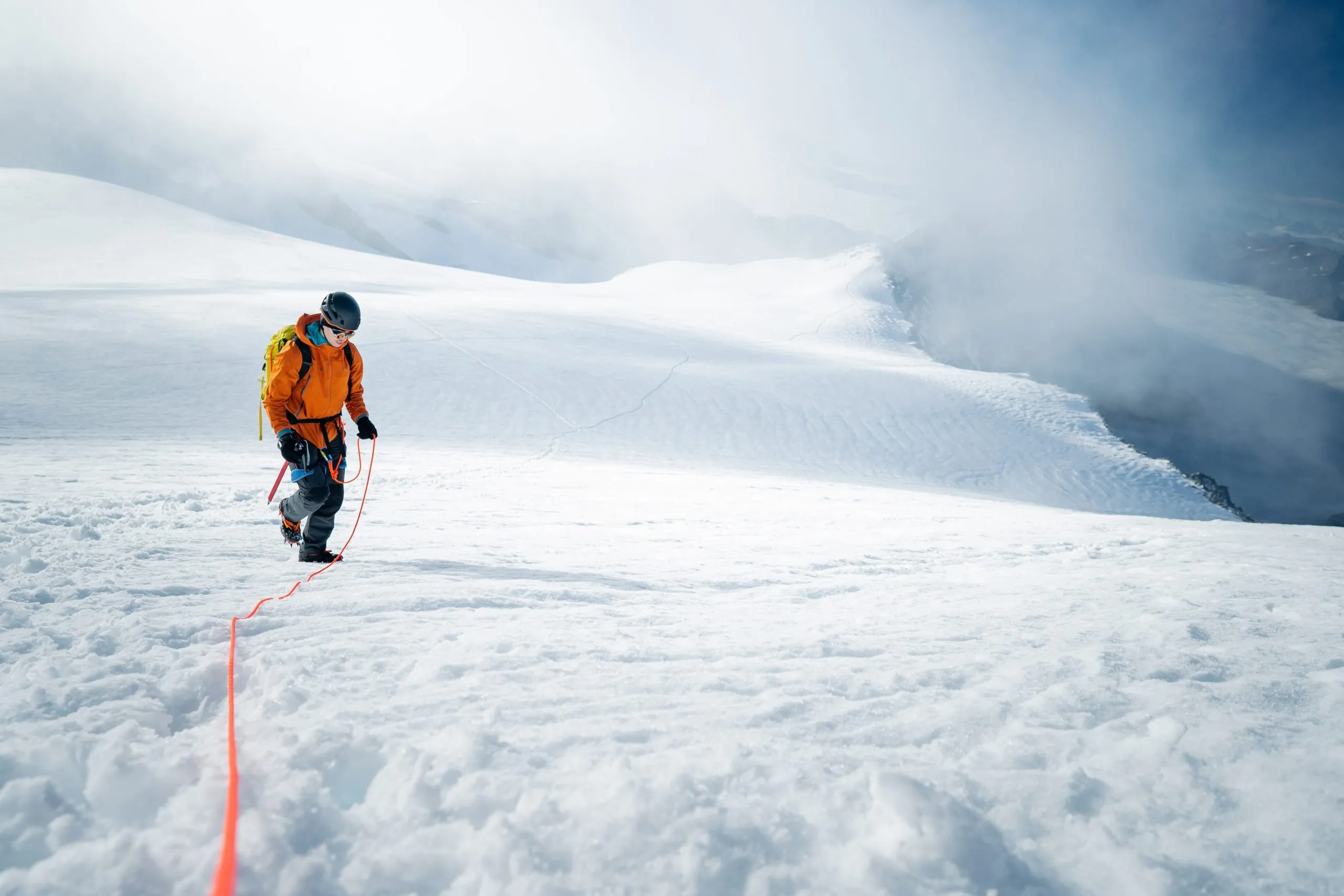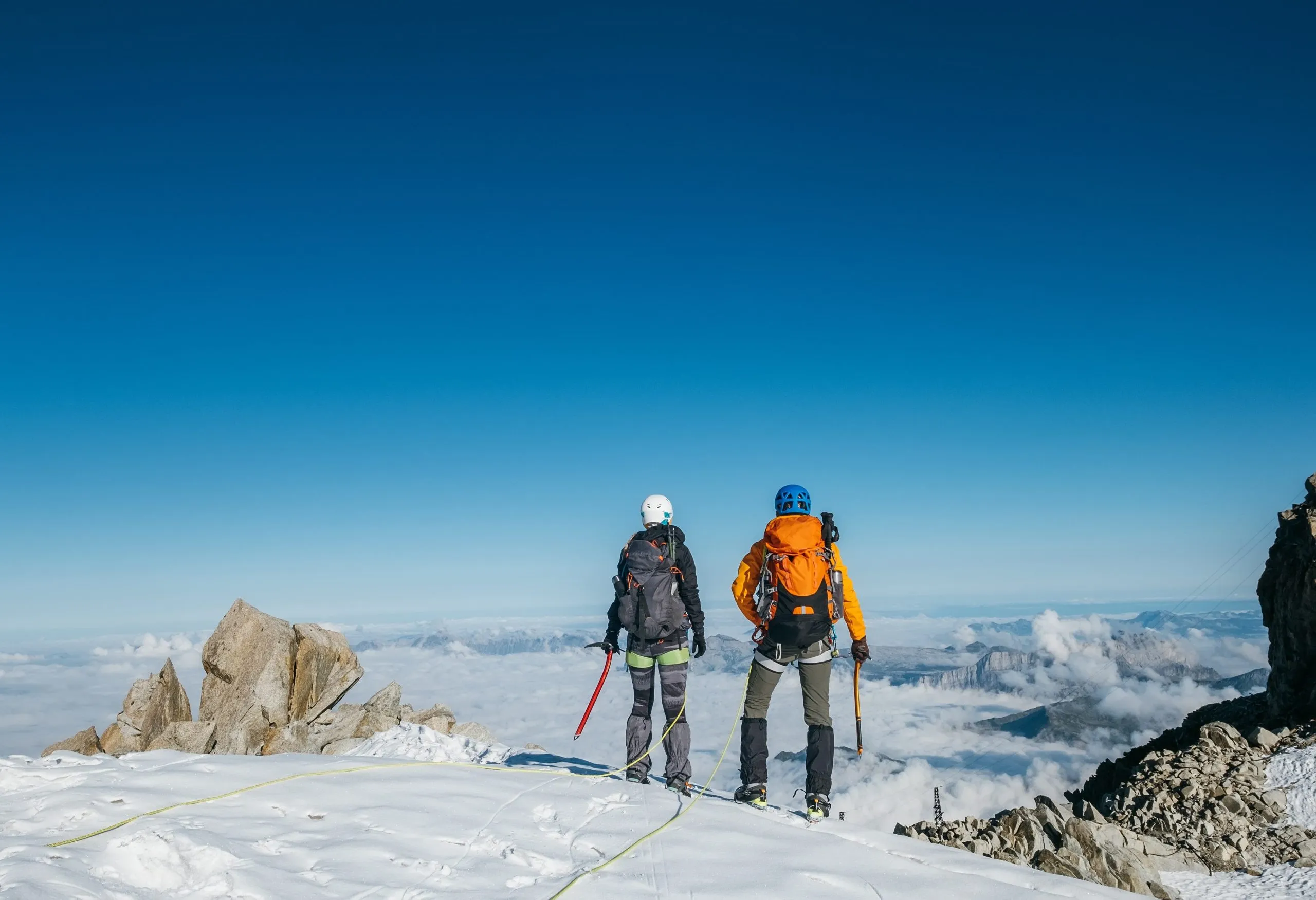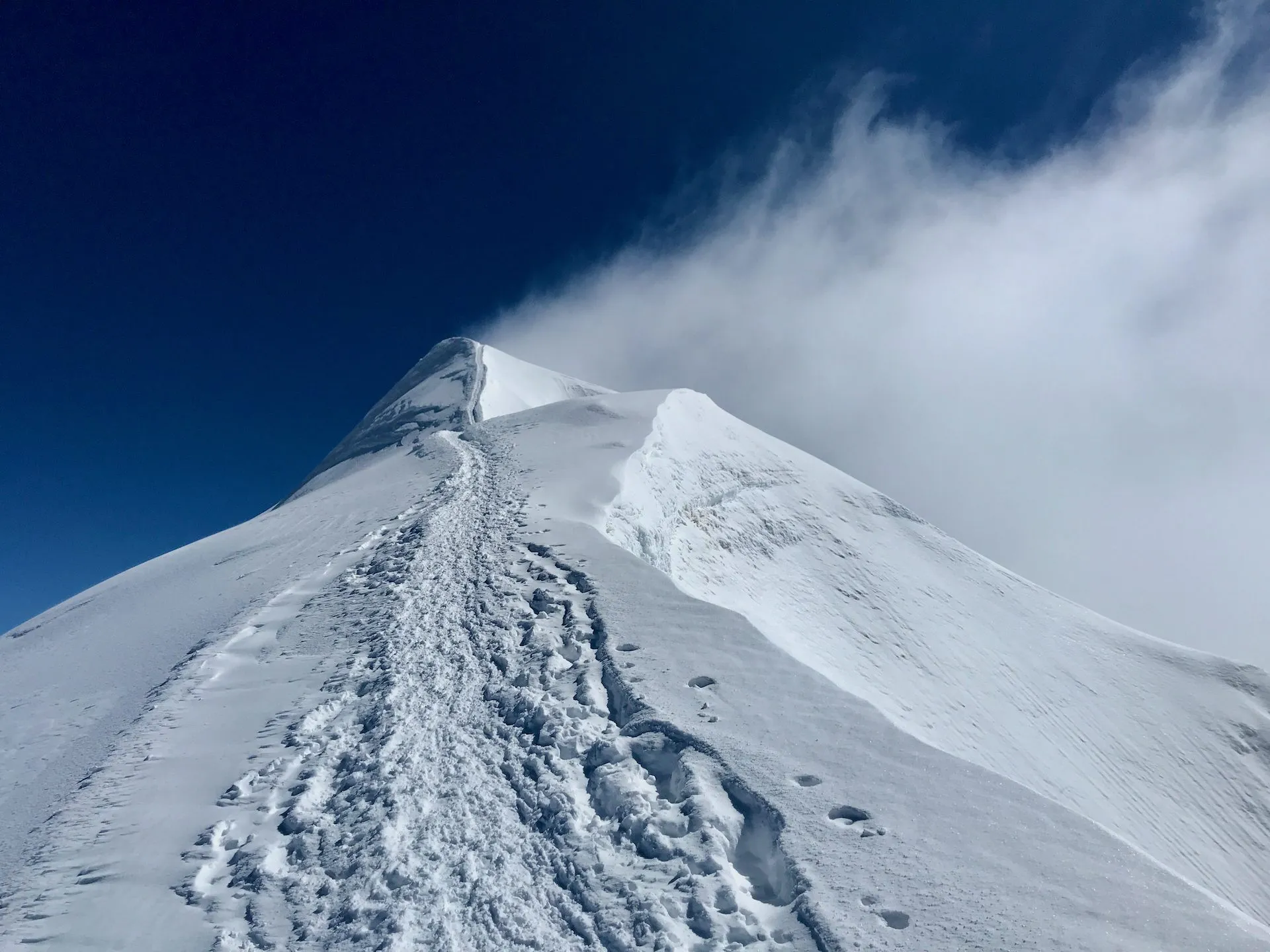The Mont Blanc climb is neither a walk in the park nor a regular Sunday hike. It’s a proper mountaineering venture, where you have to possess certain skills and be fit enough to even have a chance of standing on its summit.
Going on this Mont Blanc expedition with experienced mountain guides indeed makes it much easier since we teach you the necessary skills, but still — You are responsible for being fit enough. Arriving in Chamonix on day one and expecting us to fully prepare you without lifting a finger in the months prior just won’t do.
How fit do I need to be to summit Mont Blanc?
To be able to climb the peak of Mont Blanc, you have to have solid endurance. This doesn’t mean you have to be a good sprinter or very fast, but you must be able to withstand a long time of sustained medium intensity effort.
Your endurance has to be on such a level, that you can work at an increased heart rate for several hours straight, and be at the same time able to think clearly and communicate with other expedition members.

What does that mean in numbers? You have to be able to climb around 1600 meters of elevation in one day because that is what the hardest days on our Mont Blanc expedition look like. The difference on Mont Blanc is that the high altitude is an important factor that can make climbs 30 % harder. That means that at “low” altitude, you have to be able to do 1600 meters of elevation gain comfortably, not barely.
In the first three days of our expedition, we have the “training” climb to the Gran Paradiso. While it is primarily an acclimatization climb, it is also a test. If you can complete that climb without any significant issues, you’re ready to climb Mont Blanc. But even if you are, but we then see you are too slow and cannot reach certain locations by certain time benchmarks, the guide will turn you around, and you will not be able to summit Mont Blanc.
How to prepare for climbing Mont Blanc?
Endurance is the most important factor in your aspiration to climb Mont Blanc. That means that it should be your first concern in the months coming up to Mont Blanc. We can teach you the necessary skills quite quickly, and equipment can be bought, but gaining enough endurance takes time.
If you started from nothing, you should slowly ramp up the kilometres, elevation gain, and the intensity of the activity. Still, your training should not consist of pleasant hikes. You should feel uncomfortable when training. If not, you’ll definitely feel uncomfortable when climbing Mont Blanc and most probably not be able to reach the top.
Your end goal should be being comfortable climbing 1600 meters of elevation in one winter hiking day without being fully spent at the end. If you don’t have any nearby mountains, you can also go up to a lower peak twice or even three times.

If you are from Slovenia, there are many different climbs that you can do that are a good benchmark for climbing Mont Blanc. One of them is definitely Jalovec (2,645 m), which has a good mix of technical and endurance difficulty. An even better test is if you’re able to do a winter climb of Triglav because it has the highest elevation gain (around 1900 m) of any mountain in Slovenia. For a taste of the high altitude, you can also climb the highest peak of Austria, Grossglockner (3,798 m).
But beware, these climbs are all demanding alpinism ventures. You have to be experienced and skilled enough yourself, or go in the company of a guide. If not, you’re putting yourself in serious danger.
Which skills do we teach you?
The goal of our Mont Blanc expedition is not only to get you to the peak of Mont Blanc. We are also going to make you a better mountaineer. Even if you’re a novice, after our 6-day Mont Blanc climbing course, you’ll get many new skills that will help you with further mountaineering ventures.
The Normal Route to Mont Blanc is a diverse climb where you’ll encounter different conditions. They require various techniques that you’ll need to reach the peak.
That’s why we will be there to teach them to you — both on the way and during quick courses, like the one in the afternoon at the Chabod Hut.

Crampons and ice axe use
Crampons and an ice axe are necessary for any winter mountain ascent. Without them, we would most probably slip and slide very easily — injuring ourselves or even worse. That is why we are going to teach you how to properly use both.
You will find out what are the walking techniques with crampons, depending on the slope of the mountain. These techniques both reduce the strain put on your leg muscles and also lower the chances of catching your pants with a crampon spike which usually results in a clumsy fall. And falling uncontrollably on a big mountain like Mont Blanc can end very badly.
But a slip or a fall might still happen. There is still a chance to save ourselves, and that is why we have the ice axe.
Yes, it makes you look cooler. But besides that and keeping balance, the primary use of the ice axe in these kinds of ascents (with no climbing) is to self-arrest yourself in case of a slide. We will teach you how to do that, so you can stop yourself sliding down a slab of ice without even worsening your fall and consequently your injuries.
Glacial travel
There aren’t many, and they aren’t as dangerous as some others, but there are glaciers on Mont Blanc. And as with any glaciers, there might be crevasses, seracs, and other dangers.

That is why we will teach you about the way to travel across glaciers, tied to one another on a long rope. This way, you will know how to walk as a roped-up party on a glacier, and be prepared if one of you falls into a crevasse.
Short-rope technique
Although this technique is more of what the guides use and not about clients, it’s still an important part of the climb. In the more difficult and exposed terrain (like the Grand Couloir), the guide will be roped up to you on a short distance to reduce the likelihood of slips and falls.
You will probably feel a little bit awkward being roped up like this at first, but you should get used to it quite quickly. That will make you more comfortable and ready whenever this technique comes up in one of your next climbs.

Get ready for an adventure of a lifetime
Our Climb Mont Blanc expedition is not just a way for you to stand on the top of the highest peak in Western Europe. It is also a climbing course, where you’ll learn a lot about mountaineering and become one yourself.
Check out our program if you want to see what the course looks like — or just go straight into reserving your spot on our next Mont Blanc expedition.





